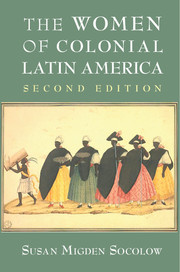Book contents
- Frontmatter
- Dedication
- Contents
- List of Figures
- Acknowledgments
- Introduction: Why Women?
- Chapter One Iberian Women in the Old World and the New
- Chapter Two Before Columbus: Women in Indigenous America and Africa
- Chapter Three Conquest and Colonization
- Chapter Four The Arrival of Iberian Women
- Chapter Five Women, Marriage, and Family
- Chapter Six Elite Women
- Chapter Seven The Brides of Christ and Other Religious Women
- Chapter Eight Women and Work
- Chapter Nine Women and Slavery
- Chapter Ten Women and Social Deviance
- Chapter Eleven Women and Enlightenment Reform
- Conclusion
- Documents
- Suggested Further Reading
- Index
- Plate section
- References
Chapter Nine - Women and Slavery
Published online by Cambridge University Press: 05 February 2015
- Frontmatter
- Dedication
- Contents
- List of Figures
- Acknowledgments
- Introduction: Why Women?
- Chapter One Iberian Women in the Old World and the New
- Chapter Two Before Columbus: Women in Indigenous America and Africa
- Chapter Three Conquest and Colonization
- Chapter Four The Arrival of Iberian Women
- Chapter Five Women, Marriage, and Family
- Chapter Six Elite Women
- Chapter Seven The Brides of Christ and Other Religious Women
- Chapter Eight Women and Work
- Chapter Nine Women and Slavery
- Chapter Ten Women and Social Deviance
- Chapter Eleven Women and Enlightenment Reform
- Conclusion
- Documents
- Suggested Further Reading
- Index
- Plate section
- References
Summary
I declare that when I married doña Margarita Mexia, she brought with her as her dowry 1,000 pesos and a black slave named Catalina de la Cruz, and that the said slave has produced seven other slaves [piezas de esclavos y esclavos] named Nicolasa Ramos, a twenty-year-old black woman; Alfonso José, a suckling child; José Ramos, an eighteen-year-old black man; Antonio Lugardo, a mulatto boy, 14 to 15 years old; Ignacio José de Ramos, a dark mulatto boy, 4 to 5 years old; and Margarita Ramos, a fair-skinned mulatta girl, between 2 and 3 years old. I declare them all to be slaves, subject to service.
Inventory taken at San Miguel de Almolonga, 1 July 1699: Among other property belonging to Don Nicolas Ramos de Bustos, we take inventory of the following slaves:
Catalina, 38-year-old black woman, married to Manuel de Rueda, free mulatto
Nicolasa, daughter of the abovementioned Catalina, 18 years old
José, 14-year-old black, son of Catalina
Antonio, a 12-year-old mulatto, son of Catalina
Margarita María, 8 years old, daughter of Catalina
Ignacio José, 5-year-old mulatto, son of Catalina
Margarita de Guadalupe, a mulatta girl, daughter of Catalina, between 2 and 3 years old
Alfonso José, 8 months old, son of the abovementioned Nicolasa [Catalina’s grandson]
Just as the women of the conquered pre-Columbian Indian populations found their lives changed forever as a result of the coming of European conquerors, the position and role of African women were permanently altered by their enslavement and transportation to the New World. Far from their communities of origin and torn from their cultures, slaves were forced to re-create a new social and religious world. They did this by accepting Hispanic forms while maintaining parts of their African heritage. Although they were viewed as legally inferior to the indigenous population, most slaves probably had closer day-to-day contact with their masters than did Indians. This was particularly true of enslaved women.
- Type
- Chapter
- Information
- The Women of Colonial Latin America , pp. 140 - 156Publisher: Cambridge University PressPrint publication year: 2015



